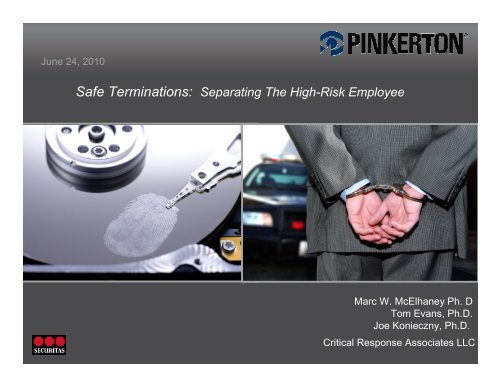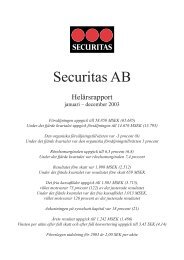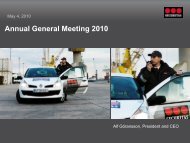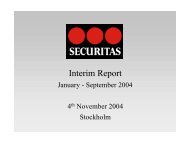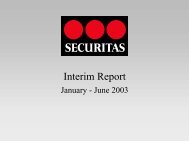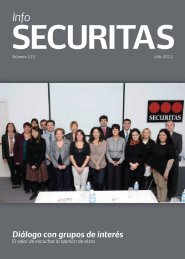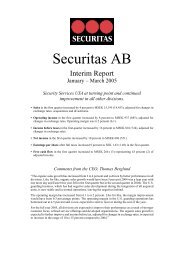Safe Terminations: Separating The High-Risk Employee - Securitas
Safe Terminations: Separating The High-Risk Employee - Securitas
Safe Terminations: Separating The High-Risk Employee - Securitas
You also want an ePaper? Increase the reach of your titles
YUMPU automatically turns print PDFs into web optimized ePapers that Google loves.
June 24, 2010<br />
<strong>Safe</strong> <strong>Terminations</strong>: <strong>Separating</strong> <strong>The</strong> <strong>High</strong>-<strong>Risk</strong> <strong>Employee</strong><br />
Marc W. McElhaney Ph. D<br />
Tom Evans, Ph.D.<br />
Joe Konieczny, Ph.D..<br />
Critical Response Associates LLC
How Bad Is It?<br />
(<strong>The</strong> Stats)<br />
• Number 1 cause of workplace death<br />
• 50% of companies report incident in 1 year<br />
• $ 121 billion/year<br />
• CDC: an “epidemic”
Costs of<br />
Workplace Violence<br />
• Personal injury & death<br />
• Property damage<br />
• Legal costs<br />
• Health care costs<br />
• Workers’ compensation claims<br />
• Other damage claims<br />
• Security costs
Costs of<br />
Workplace Violence<br />
• Damage to employee morale<br />
• Decreased efficiency<br />
• Increased absences<br />
• Diversion of resources<br />
• Reduced productivity<br />
• <strong>The</strong> company’s image
• “Each employer shall furnish to each of his<br />
employees employment and a place of<br />
employment which are free from recognized<br />
hazards that are causing or are likely to cause<br />
death or serious physical harm to his<br />
employees.”<br />
-Section 5(a) of the OSH Act<br />
“<strong>Employee</strong>s can be cited for violating the<br />
..Clause if there is a recognized hazard of<br />
workplace violence in their establishments and<br />
they do nothing to prevent or abate it.”<br />
-OSHA 3148, 1998 (Revised)<br />
Name Surname | Title of presentation | Date 5
Negligence Claims<br />
• Negligent hiring<br />
• Negligent retention<br />
• Negligent security<br />
• Negligent termination<br />
• Negligent training<br />
• Negligent referencing/duty to warn
So How Did We Get Here In the First Place?<br />
(maybe it’s not a surprise)<br />
• Mistake #1: Overusing our favorite defense<br />
mechanisms:<br />
• Delay<br />
• Denial<br />
• Avoidance<br />
• <strong>The</strong> longer you wait, the worse it gets<br />
• If possible, avoid catching someone off guard<br />
• <strong>Employee</strong>s generally should not be surprised<br />
• Managers should not give good ratings to poor<br />
performers
<strong>The</strong> Profile:<br />
<strong>The</strong>re isn’t one.<br />
(<strong>The</strong>re’s not even several)<br />
8
Violence is not a trait,<br />
it is<br />
a process.<br />
Name Surname | Title of presentation | Date 9
Primary Factors Influencing<br />
<strong>Risk</strong> Assessment<br />
1. Personality characteristics<br />
2. Emotional Status<br />
3. Cognitive Factors<br />
4. Situational and Social Factors<br />
a. Within work setting<br />
b. Outside work
1 Example:<br />
Bob,<br />
on a bad morning
Know Your <strong>Employee</strong>s!
[ Although many had<br />
information...]<br />
“no one had all the information<br />
and no one connected the<br />
dots.”<br />
Report of the Virginia Tech review Panel August 2007
What About the <strong>Employee</strong><br />
Who<br />
Just Snaps?<br />
Name Surname | Title of presentation | Date 15
Violence is just not an act,<br />
It is a<br />
process.<br />
Name Surname | Title of presentation | Date 16
Terminating the At <strong>Risk</strong><br />
<strong>Employee</strong><br />
Common Patterns<br />
Name Surname | Title of presentation | Date 17
• History of intimidation and aggressive<br />
behavior<br />
• Avoids disciplinary actions (or any<br />
kind of interaction)<br />
• Common excuses:<br />
•“We didn’t want to make him<br />
angry.”<br />
•“We just didn’t take him seriously.”<br />
•“Well, that’s just the way he is…<br />
That’s just Joe.”<br />
• Avoidance is often unconscious until<br />
the termination<br />
<strong>The</strong> Workplace Bully<br />
Name Surname | Title of presentation | Date 18
<strong>The</strong> “Disgruntled” <strong>Employee</strong><br />
• Believes that he or she has been treated unfairly<br />
• Often has many complaints, but is..<br />
• Usually overly focused on a single (or original) trauma<br />
• Has become increasingly<br />
• Withdrawn<br />
• Alienated<br />
• Egocentric<br />
• Believes that the system cannot solve their problems<br />
• Has decided that there will come a time when they may have<br />
to take things in their own hands
<strong>The</strong> Overly Attached <strong>Employee</strong><br />
• <strong>The</strong> “Pathological Affective Organizational Attachment<br />
Disorder”<br />
• <strong>The</strong> employee who literally cannot leave<br />
• <strong>Employee</strong> is overly dependent on the company for a variety of<br />
critical needs:<br />
• Identity<br />
• Self-concept<br />
• Social life/organizational network<br />
• Personal structure<br />
• Recreational activities<br />
• Work is family<br />
• Feels betrayed and rejected
<strong>The</strong> “Nothing Left to Lose” <strong>Employee</strong><br />
• Under extreme emotional<br />
distress<br />
• Has suffered recent critical<br />
losses<br />
• Feelings of hopelessness/no<br />
way out<br />
• Limited support system<br />
• Has made comments warning<br />
of possible suicidal ideation<br />
• Feels that he or she has literally<br />
“nothing left to lose”
STALKING<br />
• No person by engaging in a pattern of conduct<br />
shall knowingly cause another person to believe<br />
that the offender will cause physical harm to the<br />
other person or cause mental distress to the other<br />
person.<br />
• An attempted forced relationship
• No “Profile”<br />
STALKING<br />
• Over 21 various classification systems<br />
• Assess behavior vs. personality<br />
• Duration can last from a few weeks to years<br />
• Violence is common (approx 50%) but<br />
homicide is extremely rare > .25%
STALKING<br />
• Ratio – 14 of 1,000 person 18+<br />
• 75% knew stalker in some capacity<br />
• 43% threatened with violence<br />
• 12% reported physical violence (hit, slapped,<br />
knocked to ground)
STALKING<br />
• RECON (Meloy & Mohandie 2006) most<br />
useful<br />
• Assess the relationship of stalker/victim<br />
and context of relationship<br />
• Extremely important distinctions for risk<br />
assessment and management
STALKING<br />
• TYPE I<br />
• Prior Relationship-Private Figure<br />
• (Former boyfriend, spouse, etc)<br />
• Primarily males stalking females<br />
• Threats 83%<br />
• Physical Violence
STALKING<br />
• Physical Violence 34%<br />
• Property Damage 18%<br />
• Combined 22%
• Type II<br />
STALKING<br />
• Public Figure (No prior relationship)<br />
• Threats 18%
STALKING<br />
• Personal violence 1%<br />
• Property Violence .7%<br />
• Combined .3%<br />
• Access to this victim pool more difficult
STALKING<br />
• Motivation – Revenge vs. Forging Relationship<br />
• Restraining orders – Violated 40%<br />
• Average length of stalking – 1.3 years
<strong>Safe</strong> <strong>Terminations</strong>:<br />
A 5-Step Process<br />
1. Pause!<br />
2. Confer<br />
3. Assess<br />
4. Control, Contain & Stabilize (Call A Time Out)<br />
5. Plan!
1. PAUSE!<br />
• Mistake #2 (after delay, denial and avoidance): Acting Too<br />
Hastily<br />
• “We just want to make him go away.” But getting rid of<br />
him may not get rid of him.<br />
• Do not rush into it: hit the pause button!<br />
• Most of your options to assess and manage risk end at<br />
termination<br />
• If in doubt, wait!
2. Confer With Colleagues<br />
• If you are not certain, ask<br />
for a “reality check”<br />
• Compare notes<br />
• Surface concerns/override<br />
denial
3. Assess<br />
• Assemble your team<br />
• Collect data<br />
• Conduct a preliminary assessment<br />
• Do you have enough information?<br />
• Are your resources available?<br />
• Do you need professional consultation?<br />
• What do you need to complete your assessment?
Good Management<br />
is dependent on<br />
Good Assessment!
4. Control, Contain, & Stabilize<br />
• Call a Time-Out<br />
• Address the immediate security concerns<br />
• Control the risks and give yourself time<br />
• Exit the employee from the workplace<br />
• Conduct a preliminary risk assessment<br />
• De-fuse and reduce the emotional immediacy<br />
• Address security needs<br />
• Identify critical resources<br />
• Remember that this is a process, not an event
Exiting <strong>The</strong> <strong>Employee</strong> (Appropriately) Prior To<br />
Termination<br />
Gives You the Opportunity To:<br />
• Ensure safely/establish security<br />
• Initiate a more positive intervention/relationship<br />
• Obtain more time for planning the termination<br />
• Give the employee more time to defuse him or herself<br />
• Obtain a better, more comprehensive assessment<br />
• Test the employees ability to comply and control impulses<br />
• Help the employee through a venting/defusing process<br />
• Manage the risks down<br />
• Establish a relationship with a designated individual that can<br />
continue post-termination<br />
• Begin the separation process
5. Planning <strong>The</strong> Termination<br />
• Often a multi-step process occurring throughout<br />
the process<br />
• Plan thoroughly<br />
• Attend to the details<br />
• Rehearse<br />
• Be prepared for all foreseeable outcomes and<br />
consequences<br />
• Include your team<br />
• Identify and ready critical resources<br />
• Don’t short-cut the assessment process: know<br />
your employee
Threat Assessment During <strong>The</strong> Termination Session<br />
• Logistics “<strong>The</strong> d….l’s in the details”:<br />
oWho? Where? When?<br />
oImmediate security issues<br />
oPhysical setting<br />
oExiting process<br />
• Future security issues:<br />
oDuty to warn?<br />
oBoundaries<br />
• <strong>The</strong> Exit Interview - When and how to utilize a threat<br />
assessment professional<br />
• <strong>Risk</strong> Reduction Strategies:<br />
oDepersonalization<br />
oDelocalization
Separate Completely<br />
• Do nothing to reinforce the relationship<br />
• Set boundaries<br />
• All contacts through:<br />
• Designated channels<br />
• Outside agents<br />
• Resources facilitated by outside agents<br />
• Consider outplacement services
Think Long-Term<br />
• Know the employee: be prepared for future issues<br />
• Be proactive!<br />
• Consider contractual arrangements<br />
• Utilize community support systems<br />
• Decide whether legal measures are required<br />
• Address physical security concerns<br />
• Set up a strategic monitoring system (often indirect)<br />
• Utilize outside agents<br />
• Be creative!
<strong>Safe</strong> <strong>Terminations</strong>: Final Words<br />
• Good Management is Dependent on Good<br />
Assessment and Planning – Slow it Down!<br />
• Remember: It’s the Process!<br />
• Be Fair and Respectful!<br />
• Think Long-Term!<br />
• Think Creatively! (each is different)<br />
• Don’t Go It Alone!
Common Mistakes/<br />
Flashpoints<br />
Name Surname | Title of presentation | Date 43
1. Avoidance, Denials, & Delays<br />
• “He just kinda snapped.”<br />
• “How did we let it get this far?”<br />
• “Well, we don’t really have anything in his file.”<br />
• “But his performance appraisals have been great.”
Avoiding<br />
<strong>The</strong> Workplace Bully<br />
• “We didn’t want to make him angry”<br />
• “Well, that’s just Joe – That’s just the way<br />
he is.”
2. Managers Not Attending<br />
To Aberrant Behaviors<br />
• “He hasn’t been himself lately.”<br />
• “He just gives everyone the creeps.”<br />
• “She said something about her husband<br />
being out to get her.”
3. Not Having a Threat Response<br />
Plan or Team in Place<br />
Relying on <strong>The</strong> One-Stop (Non-)Solutions:<br />
• “We’ll just call the police.”<br />
• “We referred him to the EAP.”
4. Lack of <strong>Employee</strong>s’ Support<br />
and Participation<br />
• “We didn’t want to make him angry.”<br />
• “We just didn’t take him seriously.”<br />
• “I just didn’t think it’d do any good.” (to<br />
report it)<br />
• “I didn’t want to get in trouble.”
Lack of Understanding of Terms and Policy<br />
• “Well, he didn’t actually make a threat.”<br />
• “Heck, we were just playing around.”<br />
• “I didn’t know who to call.”
Do Your <strong>Employee</strong>s Know Your<br />
Do Your <strong>Employee</strong>s Know Your<br />
Definition Of Violence, Per Your<br />
Definition Of Violence, Per Your<br />
Policy?<br />
Policy?
How Do You Define<br />
“Violence”?<br />
i.e., “any conduct that creates an<br />
intimidating, hostile, offensive or threatening<br />
working environment through unwelcome<br />
words, actions, or physical contact.”
Do Your <strong>Employee</strong>s Know<br />
What You Expect of <strong>The</strong>m?<br />
Is there a Training Program in<br />
Place?
Essential Training Programs<br />
• Threat Assessment Team Training<br />
• Critical Personnel (HR, Security, Legal..)<br />
• Managers & Supervisors<br />
• General <strong>Employee</strong> Awareness
5. Acting Too Hastily<br />
(not preparing for critical events)<br />
“We just wanted to get rid of him.”
Critical Response Associates<br />
www.craorg.com<br />
404-870-9777<br />
info@craorg.com<br />
Dr. Marc McElhaney (Atlanta)<br />
mobile: 404-441-5793<br />
Dr. Tom Evans (Cleveland)<br />
mobile: 440-263-0266<br />
Dr. Joe Konieczny (Cleveland)<br />
mobile: 440-221-3791
We Never Sleep<br />
www.ci-pinkerton.com<br />
Name Surname | Title of presentation | Date 56
Contact Information:<br />
Gary Fonce- Director of Operations<br />
216-520-5200 Office<br />
216-244-1990 Cell<br />
gary.fonce@ci-pinkerton.com<br />
Mark Jones- Director of Sales<br />
214-619-3080 Office<br />
214-679-5282 Cell<br />
mark.jones@ci-pinkerton.com<br />
www.ci-pinkerton.com<br />
We Never Sleep<br />
Name Surname | Title of presentation | Date 57


